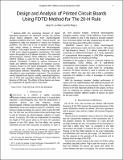| dc.contributor.author | Jiang, Yi | |
| dc.contributor.author | Li, Le-Wei | |
| dc.contributor.author | Li, Er-Ping | |
| dc.date.accessioned | 2003-12-23T02:11:38Z | |
| dc.date.available | 2003-12-23T02:11:38Z | |
| dc.date.issued | 2002-01 | |
| dc.identifier.uri | http://hdl.handle.net/1721.1/3996 | |
| dc.description.abstract | With the increasing demand of higher operating frequencies for electronic circuits, the printed circuit board designers face more electromagnetic radiation problems than ever. Some “rules-of-thumb” are employed to help the designers to reduce the radiation problems. The 20H rule is one of printed circuit design rules, which intends to minimize the electromagnetic radiation. This project focuses on analysis and simulation of 20H rule’s signal propagation mechanisms. The model used in the project is a 2D planar structure. The numerical electromagnetic method, Finite Difference Time Domain (FDTD) method, is used for the field computation and analysis. Simulation is based on various structures of model and different distributions of excitation sources. Analysis focuses on the signal propagation models. Field distributions and radiation patterns are visualized by mathematical software. Meanwhile, Poynting vectors are calculated to give quantitative expression. The simulation results indicate three factors, namely, operating frequency, size of PCB and separation distance that will affect the function of 20H rule. The effects of three factors are shown by comparison of specific cases in this thesis. | en |
| dc.description.sponsorship | Singapore-MIT Alliance (SMA) | en |
| dc.format.extent | 139471 bytes | |
| dc.format.mimetype | application/pdf | |
| dc.language.iso | en_US | |
| dc.relation.ispartofseries | High Performance Computation for Engineered Systems (HPCES); | |
| dc.subject | PCB | en |
| dc.subject | 20H Rule | en |
| dc.subject | FDTD | en |
| dc.subject | EMI/EMC | en |
| dc.title | Design and Analysis of Printed Circuit Boards Using FDTD Method for The 20-H Rule | en |
| dc.type | Article | en |
